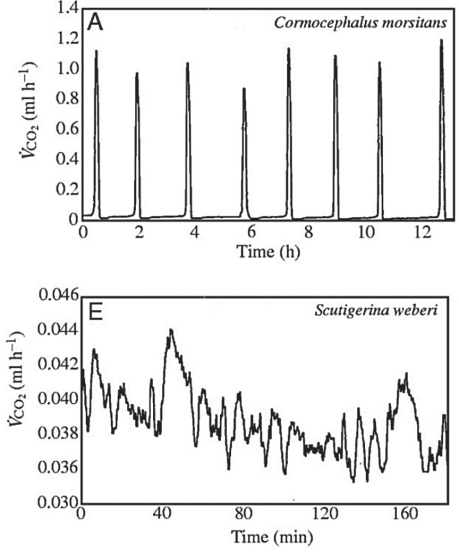Use the following information when answering the corresponding questions) .
Many terrestrial arthropods exchange gases with their environments by using tracheae, tubes that lead from openings called spiracles) in the animal's exoskeleton or cuticle directly to the animal's tissues. Some arthropods can control whether their spir opened or closed; opening the spiracles allows the carbon dioxide produced in the tissues to travel down the tracheae and be released outside the animal. Klok et al. measured the carbon dioxide emitted over time represented by VCO2) by several species of centipedes. Figure 31.2 presents graphs of their results for two species, Cormocephalus morsitans and Scutigerina weberi. C. J. Klok, R. D. Mercer, and S. L. Chown. 2002. Discontinuous gas- exchange in centipedes and its convergent evolution in tracheated arthropods.  Figure 31.2
Figure 31.2
-How would a terrestrial centipede most likely benefit from the ability to close its spiracles?
A) The centipede would not benefit at all.
B) Closing spiracles would allow the centipede to move more quickly.
C) Closing spiracles would allow the centipede to stay warmer.
D) Closing spiracles would allow more oxygen from the environment to reach the centipede's tissues.
E) Closing spiracles would allow the centipede to retain more moisture in its tissues.
Correct Answer:
Verified
Q20: Which of the following attributes is not
Q21: A cephalopod's tentacles are modified from its
A)
Q22: What is the only group of Mollusca
Q23: If you wanted to identify an unfamiliar
Q24: Use the following information when answering the
Q26: What is not true of all arthropods?
A)
Q27: What do all the Lophotrochozoa phyla discussed
Q28: What would be the most direct effect
Q29: What would be the best anatomical feature
Q30: How could you tell a millipede apart
Unlock this Answer For Free Now!
View this answer and more for free by performing one of the following actions

Scan the QR code to install the App and get 2 free unlocks

Unlock quizzes for free by uploading documents